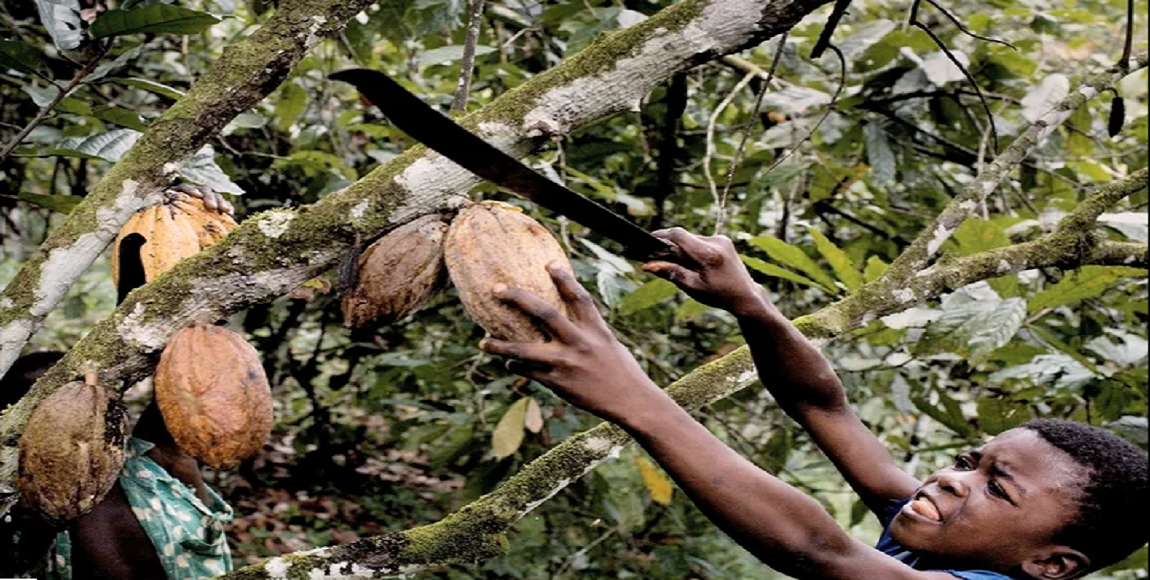The truth about the chocolate industry might leave a bitter taste in your mouth. Chocolate is a billion-dollar industry but it is not necessarily a fair one; child labour and human trafficking are a well-known part of the chocolate-making process. The Daily Vox explains.
Where does chocolate come from?
Chocolate is made from cacao beans, which grow on trees in warmer, wet climates. Almost 70% of the world’s chocolate comes from West Africa. Cote d’Ivoire is the world’s number one chocolate producer, contributing to over 30% of the world’s production.
In 2014 the total global retail value sales of chocolate was $100 billion. Many farmers and workers on cacao plantations, however, survive on just $1.25 – or R16,50 – a day.
Besides the usual tale of capitalism, there’s a darker side to chocolate production. Close to 1.8 million children in West Africa are used as labour – many of them trafficked to work on cacao farms as slaves.
Why is cacao harvesting and processing dangerous for children?
Child labour is defined by the International Labour Organisation as work that deprives children of their childhood, dignity and potential; and is physically and mentally harmful to their development. It also often interferes with their schooling.
Cacao picking lasts the whole year which makes school attendance difficult. In 2002, the International Institute of Tropical Culture found that child labourers are less likely to attend school. In Cote d’Ivoire, 34% of children on cacao farms attended school compared to 64% of children who did not work on farms.
Children have to mix and apply hazardous pesticides and fungicides which can result in pesticide contamination – especially because they don’t wear protective clothing. Clearing vegetation and harvesting pods can be dangerous because they have to wield sharp, heavy machetes.
The study found that 284 000 children working in dangerous conditions in West Africa, 153 000 applied pesticides without protective equipment, others picked pods and opened them to get the beans. Most of the children (64%) were younger than 14 and 40% were female.
Children often began working at 6am, worked 12-hour days and were beaten regularly. Farm owners often withheld their meals if they tried to escape or did not meet work expectations.
Why are cacao farms exploiting kids?
Cacao farmers use the cheapest labour to keep cocoa prices low and still make profit. Child labourers between the ages of 12 and 15 work as much as an adult labourers in the cocoa industry, but they are paid less.
How widespread is child trafficking in the cocoa industry?
A 2002 survey said about 12 000 child labourers had been trafficked in Cote d’Ivoire. Since international attention, offenders have been less brazen about their trafficking. Activists and law enforcement officials agree that the number of children affected has probably fallen since then but say trafficking and forced labour is still prevalent.
Where do the children come from?
According to Unicef, children trafficked into Cote d’Ivoire to work on cacao farms come from neighbouring countries like Mali, Benin, Cameroon and Togo. These children are plucked from poverty – begging near bus stops – and promised money and jobs only to be lured into slavery.
Who is responsible for slavery and trafficking?
No one is held accountable for slavery in cocoa production. Those who sell children to farmers claim they’re not involved in slavery and are just transporting children from their home towns to places offering work. The Ivorian government accuses foreigners of using and selling slaves, blames multinational chocolate companies for keeping cocoa prices low and farmers in poverty, and claims the low prices offered for cocoa forces some farmers to use slave labour.
Farmers who buy slaves blame the worldwide cost of cocoa. In turn, cocoa suppliers claim they cannot manage what happens on the farms, and chocolate companies say suppliers need to provide cocoa that was not produced by slaves.
What does the law say?
In 2001 many of the world’s largest chocolate producers signed an international voluntary agreement, called the Harkin-Engel Protocol, in response to the reports of human rights violations in the industry. They vowed to end child slavery in 2008. In June 2008, the protocol was extended until the end of 2010. Today, child slavery still plays a role in chocolate production.
So my chocolate bar is still tainted by child slavery. What can I do?
There are some ventures against child exploitation in the chocolate industry. You can opt to buy chocolate with a Fairtrade label. Fairtrade is the world’s leading ethical certification of product supply chains committed to protecting human rights and the environment. Some chocolate manufacturers are certified by Fairtrade but Fairtrade cocoa production does not make the same profit as non-Fairtrade cocoa. This makes it less appealing to manufacturers so Fairtrade chocolate tends to be more expensive than other chocolate. It’s also not as easy to come by.
You can also support campaigns like Make Chocolate Fair, an international campaign coordinated by civil society organisations across Europe. It is backed by several human rights and environmental groups and calls for the abolition of slavery, adequate income for cacao farmers and employees, and decent working conditions.









